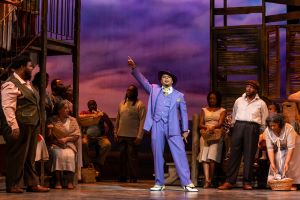When a lengthy symphony is to be performed, setting the rest of the program can be a problem. A happy little overture seems incongruous, and most concertos are too long. Music Director Daniel Meyer and the Asheville Symphony Orchestra solved the problem with a brief new Percussion Concerto by established American composer David Stock. After intermission and a resetting of the stage, the Asheville Symphony Chorus and members of the Brevard College Chorus then joined the orchestra for Beethoven’s “Choral” Symphony No. 9 in D minor.
The Stock concerto was commissioned with percussionist Lisa Pegher in mind, and she was the soloist with the ASO. There has been a renewed interest in the solo percussion repertoire ever since Evelyn Glennie, the Scottish virtuoso percussionist, arrived on the scene. While Ms. Pegher does not have the balletic grace of Ms. Glennie (whose performances are a feast for the eyes as well as the ears), she has strong technical ability, and she gave the audience a fair chance to evaluate David Stock’s new work. Before the performance began, Maestro Mayer gave a cogent description of the piece, preparing the capacity crowd for the music they were about to hear.
Unfortunately the Stock composition was unsuccessful. The work begins with a chorale-like orchestral passage and a totally contrasting loud percussion statement that caused this listener to ask himself, “how will this ever get unified?” The answer was that it would not. The musical goal of tension and release is not reached in this movement, nor is that initial tension resolved even in the second or third movements. In the slow movement, the soloist is in a contemplative mood on a five-octave marimba. Neither the first nor the second movement, strangely, displayed any passages having particular rhythmic interest. Until the third movement, the work flew in the face of the fundamental idea of a percussion concerto.
The third movement was much better, beginning with an interesting percussion riff that reminded me of vintage Stan Kenton (perhaps “City of Glass”) and continuing with good counterpoint passages and an interesting cadenza. The energy of the third movement showed that Stock can write much better music than the confusing first movement. That first movement needs serious rework; perhaps then the work can be made coherent and provide a stronger statement. As now presented, Stock’s concerto is a musical lightweight compared, for example, to the Joseph Schwantner percussion concerto.
The Beethoven Ninth Symphony was another story. I doubt that any member of the orchestra or of the Asheville Symphony Chorus was encountering the magisterial work for the first time, and their confidence showed. Even the four young soloists (all from the Cincinnati College Conservatory of Music) and Brevard College chorus members were probably veterans of the piece.
I detected a false entry (quickly corrected) by a bassoon, and in one choral passage the sopranos were not all successful at reaching the pitch. But the woodwinds were excellent throughout, and the declamatory cello and bass passage at the beginning of the fourth movement was lush and stirred the heart with its humanity. All aspects of the performance once more underscored Beethoven’s romantic belief in the goodness of mankind. Meyer’s tempi were at the fast end of the “standard” range but had appropriate dignity conjoined with the excitement of the music. This was a performance that was so finely honed in interpretation that any orchestra could have felt proud.
It bears repeating: the quality of the Asheville Symphony Orchestra under Daniel Meyer justifies fully the Asheville community’s efforts to build a concert hall with acoustic quality to match. Kudos to those who continue the effort despite the economic downturn.











